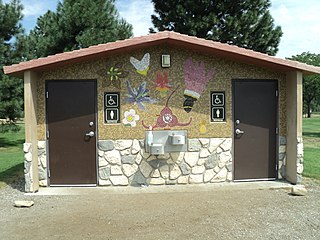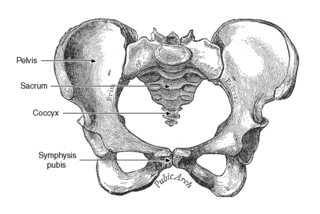Related Research Articles

Emergency contraception (EC) is a birth control measure, used after sexual intercourse to prevent pregnancy.

A bathroom or washroom is a room, typically in a home or other residential building, that contains either a bathtub or a shower. The inclusion of a wash basin is common. In some parts of the world e.g. India, a toilet is typically included in the bathroom; in others, the toilet is typically given a dedicated room separate from the one allocated for personal hygiene activities. In the United States the word 'bathroom' is often used to refer to any room that contains a toilet, regardless of the inclusion of a bath or shower.
The pregnancy category of a medication is an assessment of the risk of fetal injury due to the pharmaceutical, if it is used as directed by the mother during pregnancy. It does not include any risks conferred by pharmaceutical agents or their metabolites in breast milk.
Atenolol is a beta blocker medication primarily used to treat high blood pressure and heart-associated chest pain. Atenolol, however, does not seem to improve mortality in those with high blood pressure. Other uses include the prevention of migraines and treatment of certain irregular heart beats. It is taken by mouth or by injection into a vein. It can also be used with other blood pressure medications.

Fluconazole is an antifungal medication used for a number of fungal infections. This includes candidiasis, blastomycosis, coccidioidomycosis, cryptococcosis, histoplasmosis, dermatophytosis, and pityriasis versicolor. It is also used to prevent candidiasis in those who are at high risk such as following organ transplantation, low birth weight babies, and those with low blood neutrophil counts. It is given either by mouth or by injection into a vein.

A public toilet, restroom (US), public bathroom or washroom is a room or small building with toilets and sinks for use by the general public. The facilities are available to customers, travelers, employees of a business, school pupils and prisoners and are commonly separated into male and female toilets, although some are unisex, especially for small or single-occupancy public toilets.
The triple test, also called triple screen, the Kettering test or the Bart's test, is an investigation performed during pregnancy in the second trimester to classify a patient as either high-risk or low-risk for chromosomal abnormalities.

Quinapril, sold under the brand name Accupril among others, is a medication used to treat high blood pressure (hypertension), heart failure, and diabetic kidney disease. It is a reasonable initial treatment for high blood pressure. It is taken by mouth.

Pruritic urticarial papules and plaques of pregnancy (PUPPP), known in United Kingdom as polymorphic eruption of pregnancy (PEP), is a chronic hives-like rash that strikes some women during pregnancy. Some skin changes are known to occur in people who are pregnant while other skin conditions, or dermatoses, that people have prior to getting pregnant will become altered or symptoms will increase. Pruritic urticarial papules and plaques of pregnancy (PUPPP) is one of many skin conditions that is specific to pregnancy and occurs in about 1 in every 160 (0.625%) of pregnancies.

Unisex public toilets are public toilets that are not separated by gender or sex.

A package insert is a document included in the package of a medication that provides information about that drug and its use. For prescription medications, the insert is technical, providing information for medical professionals about how to prescribe the drug. Package inserts for prescription drugs often include a separate document called a "patient package insert" with information written in plain language intended for the end-user—the person who will take the drug or give the drug to another person, such as a minor. Inserts for over-the-counter medications are also written plainly.

Symphysis pubis dysfunction (SPD), commonly known as pubic symphysis dysfunction or lightning crotch, is a condition that causes excessive movement of the pubic symphysis, either anterior or lateral, as well as associated pain, possibly because of a misalignment of the pelvis. Most commonly associated with pregnancy and childbirth, it is diagnosed in approximately 1 in 300 pregnancies, although some estimates of incidence are as high as 1 in 50.
In medicine, an indication is a valid reason to use a certain test, medication, procedure, or surgery. There can be multiple indications to use a procedure or medication. An indication can commonly be confused with the term diagnosis. A diagnosis is the assessment that a particular [medical] condition is present while an indication is a reason for use. The opposite of an indication is a contraindication, a reason to withhold a certain medical treatment because the risks of treatment clearly outweigh the benefits.
Therapeutic privilege refers to the decision of a healthcare practitioner to withhold information from a patient when there is a justified belief that disclosure may cause serious mental or physical harm to them. As of 2022, this defence is permissible in countries such as Australia, Canada, England, Netherlands and Wales as an exception to the standard consent process. Despite this, there are very limited cases in which therapeutic privilege has been upheld. This is mainly due to the complex ethical and legal ramifications in withholding information from a patient and how to define someone as being at sufficient risk to fall into this category wherein therapeutic privilege should prevail. Another challenge in enacting therapeutic privilege is the consideration of other professionals involved in patient care, such as where there is a multidisciplinary care team. However, in withholding information, there is also a denial of patient autonomy

Bed rest, also referred to as the rest-cure, is a medical treatment in which a person lies in bed for most of the time to try to cure an illness. Bed rest refers to voluntarily lying in bed as a treatment and not being confined to bed because of a health impairment which physically prevents leaving bed. The practice is still used although a 1999 systematic review found no benefits for any of the 17 conditions studied and no proven benefit for any conditions at all, beyond that imposed by symptoms.
Women should speak to their doctor or healthcare professional before starting or stopping any medications while pregnant. Non-essential drugs and medications should be avoided while pregnant. Tobacco, alcohol, marijuana, and illicit drug use while pregnant may be dangerous for the unborn baby and may lead to severe health problems and/or birth defects. Even small amounts of alcohol, tobacco, and marijuana have not been proven to be safe when taken while pregnant. In some cases, for example, if the mother has epilepsy or diabetes, the risk of stopping a medication may be worse than risks associated with taking the medication while pregnant. The mother's healthcare professional will help make these decisions about the safest way to protect the health of both the mother and unborn child. In addition to medications and substances, some dietary supplements are important for a healthy pregnancy, however, others may cause harm to the unborn child.

A hospital bed or hospital cot is a bed specially designed for hospitalized patients or others in need of some form of health care. These beds have special features both for the comfort and well-being of the patient and for the convenience of health care workers. Common features include adjustable height for the entire bed, the head, and the feet, adjustable side rails, and electronic buttons to operate both the bed and other nearby electronic devices.
Methadone maintenance treatment (MMT) utilizes methadone to treat dependence on heroin or other opioids, and is administered on an ongoing basis. Methadone is an opioid agonist that binds to the same receptors in the brain as heroin and other opioids. MMT is administered with the objective of relieving withdrawal symptoms. Higher doses of methadone may cause respiratory depression and/or euphoria in some patients. Methadone maintenance reduces the cravings for other opioids, and reduces the risk of fatal overdose from street drugs since the purity and strength of methadone is known, whereas substances obtained from the street vary significantly in strength and purity. Methadone maintenance has been termed "a first step toward social rehabilitation" because it increases the retention of patients in treatment, relieves them from the need to find, buy, and use multiple daily doses of street opioids, and offers a legal medical alternative.
A medical abortion, also known as medication abortion, occurs when drugs (medication) are used to bring about an abortion. Medical abortions are an alternative to surgical abortions such as vacuum aspiration or dilation and curettage. Medical abortions are more common than surgical abortions in most places, including Europe, India, China, and the United States.
Workers' right to access the toilet refers to the rights of employees to take a break when they need to use the toilet. The right to access a toilet is a basic human need. Unless both the employee and employer agree to compensate the employee on rest breaks an employer cannot take away the worker's right to access a toilet facility while working. There is limited information on the rights workers have to access public toilets among the world's legal systems. The law is not clear in New Zealand, United Kingdom, or the United States of America as to the amount of time a worker is entitled to use a toilet while working. Nor is there clarification on what constitutes a 'reasonable' amount of access to a toilet. Consequently, the lack of access to toilet facilities has become a health issue for many workers. Issues around workplace allowance to use a toilet has given light on issues such as workers having to ask permission to use a toilet and some workers having their pay deducted for the mere human right of using a toilet when they need to.
References
- ↑ Maloni, Judith A.; Cohen, Arnold W.; Kane, Janet H. (1998). "Prescription of Activity Restriction to Treat High-Risk Pregnancies". Journal of Women's Health. 7 (3): 351–358. doi:10.1089/jwh.1998.7.351. PMID 9580915.
- "Despite side effects, bed rest still common for high-risk pregnancy". University of Wisconsin–Madison (Press release). June 10, 1998.
- ↑ Galanti | Cultural Diversity in Healthcare
- ↑ "The agreement covers everything from cigarette breaks to bathroom privileges"—describing a racetrack labor union contract in: T. D. Thornton (2007). Not by a Long Shot: A Season at a Hard Luck Horse Track. ISBN 1-58648-449-4.